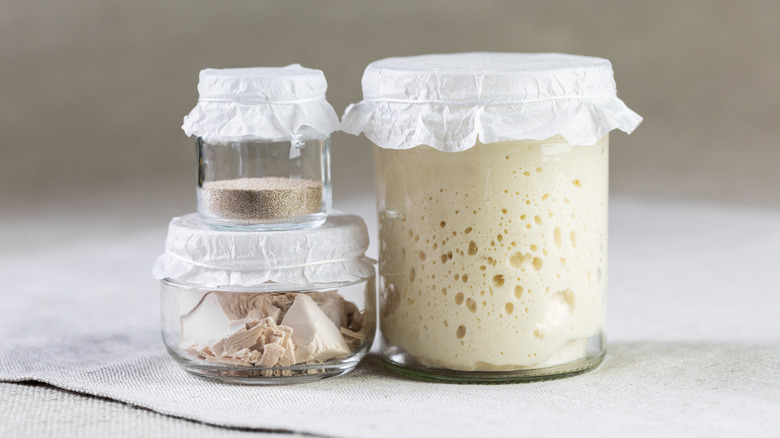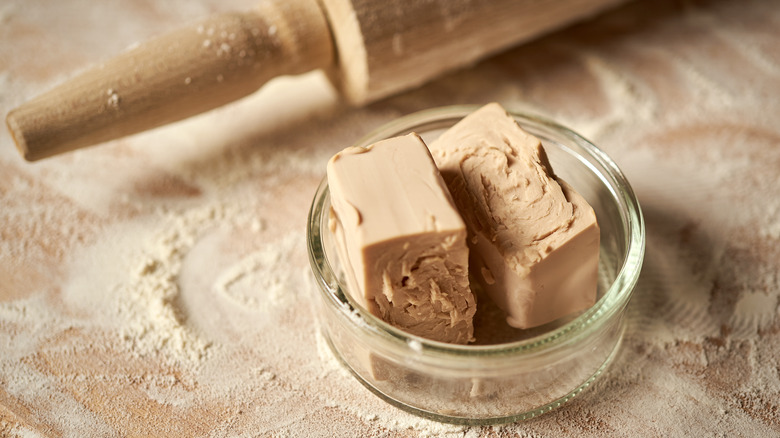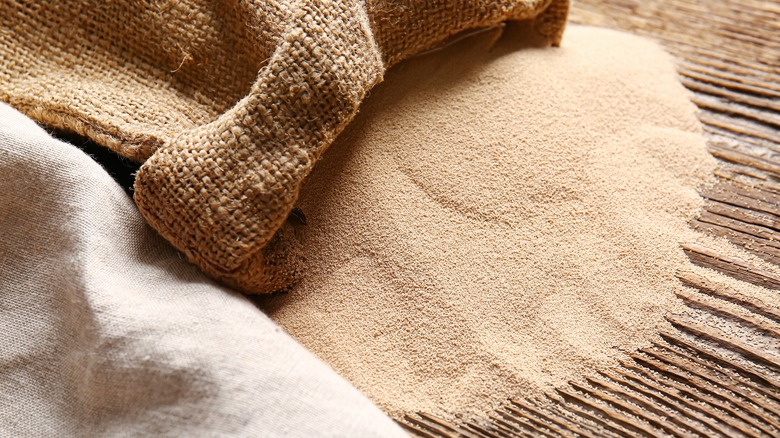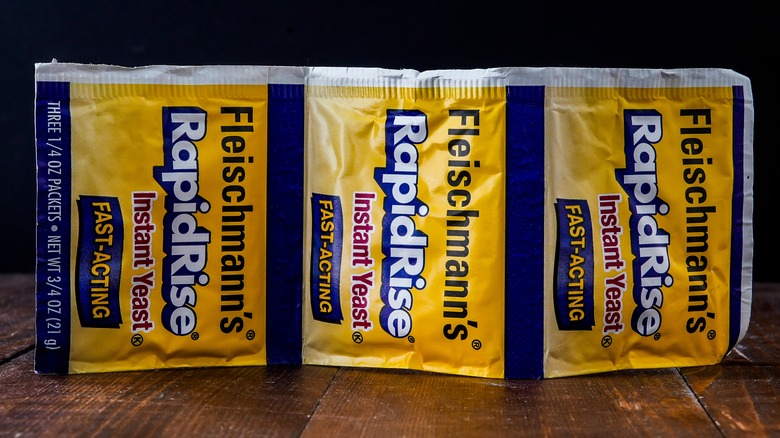Cake Vs. Dry Vs. Instant Yeast: What's The Difference?
It's always important to have the right tool for the job. That holds just as true in the kitchen, and includes having the right ingredients as well. Yeast is no exception to the rule. While most bakers think of yeast as the powdery ingredient that helps their bread rise, it's much more complicated than that.
Yeast, or Saccharomyces cerevisiae, is a single-celled fungus commonly known as brewer's or baker's yeast, and there are more than 1,500 varieties of yeast around the world, per MasterClass. There are even different types of yeast in the air that we breathe that live off of the natural sugars in fruits, grains and vegetables (via Cultures for Health).
Yeast plays a key role in fermentation, which is the process that adds structure, texture, and flavor to baked goods. Fermentation is the process in which yeast consumes the sugars and starches present in dough to produce gasses like carbon dioxide and other compounds.
Mastering this process is a huge step in crafting the perfect loaf of homemade bread or yeast cake, and knowing how to use each type of yeast is the first step in that process. Most commercial yeasts will have a similar flavor, but knowing how to work with each kind is an important part of understanding how they influence fermentation.
What is cake yeast?
First up is cake yeast, also known as fresh yeast, wet yeast, or compressed yeast. Red Star Yeast says that it was the first type of commercial yeast available to bakers at home. It is the least shelf stable of the main commercial yeasts, and is usually found in the refrigerated foods aisle. Red Star says it's often sold as a seasonal product as well, and it may not be found in certain areas depending on the time of year.
The key feature to cake yeast is that it is sold in wet bricks instead of as a dried powder. This is why it lacks the same shelf life as its dehydrated counterparts. Because it is so perishable, cake yeast needs to be sealed in an airtight container for storage. MasterClass says the compressed yeast can last in the refrigerator for up to two weeks if sealed properly.
This type of yeast is often preferred by professional bakers because of its high moisture content, per Modernist Cuisine. To use cake yeast, which when cut in blocks resembles modeling clay, must be dissolved in a liquid first. MasterClass notes cake yeast is best suited for baked goods with a longer rise time like a brioche; sweet doughs typically take longer to rise.
What is active dry yeast?
Active dry yeast, or ADY, is essentially a form of cake yeast that has been dehydrated for a more stable shelf life (via MasterClass). It's made by introducing a single strain of yeast to a food source, and kept away from naturally occurring wild yeasts. The yeast that forms from this feeding period is then separated from the mixture, dried under extreme heat, and crushed into small grains. This process helps to preserve the yeast by trapping it in a protective barrier that needs to be broken down before it can be used.
This is why active dry yeast needs to be rehydrated in water before it can be added to a recipe. To proof ADY, add the yeast to a dish of warm water with a teaspoon of sugar, and let it sit for 5-10 minutes, or until bubbles start forming on the water's surface, per King Arthur Baking. While this type of yeast is more shelf stable than cake yeast, it should be stored in the refrigerator once the package has been opened.
According to Natsume Aoi, a pastry chef instructor at the Institute of Culinary Education, "active dry yeast is great to use in breads that can be made quickly in one day and for lean breads such as baguettes and rolls" (via Insider).
What is instant yeast?
Instant dry yeast, or IDY, is the most potent of these three commercial yeasts. Per French yeast manufacturer Lesaffre, the company was the first to produce instant dry yeast for home use in 1973. The product, called Saf-instant yeast, was made to offer greater fermentation power in a smaller size.
As MasterClass explains, instant dry yeast is made in a similar way to active dry yeast but is milled to be even more granular. Because of its fine size, IDY breaks down more easily and takes less time to rise. It also doesn't need to be hydrated before use and can be added directly to the rest of your ingredients. Similar to active dry yeast, unopened packages of instant dry yeast can be stored at room temperature but should be stored and refrigerated in an airtight container after being opened.
IDY will also sometimes be called bread machine yeast or rapid rise yeast. Bread machine yeast is labeled accordingly to help consumers easily find the yeast that they need (via Bread and Buzz). Rapid rise claims to help dough rise in half the time, and will often include ascorbic acid or other dough conditioners, per MasterClass. These are meant to strengthen the gluten during the fast rise, and help provide a softer crumb without the extra wait time.



